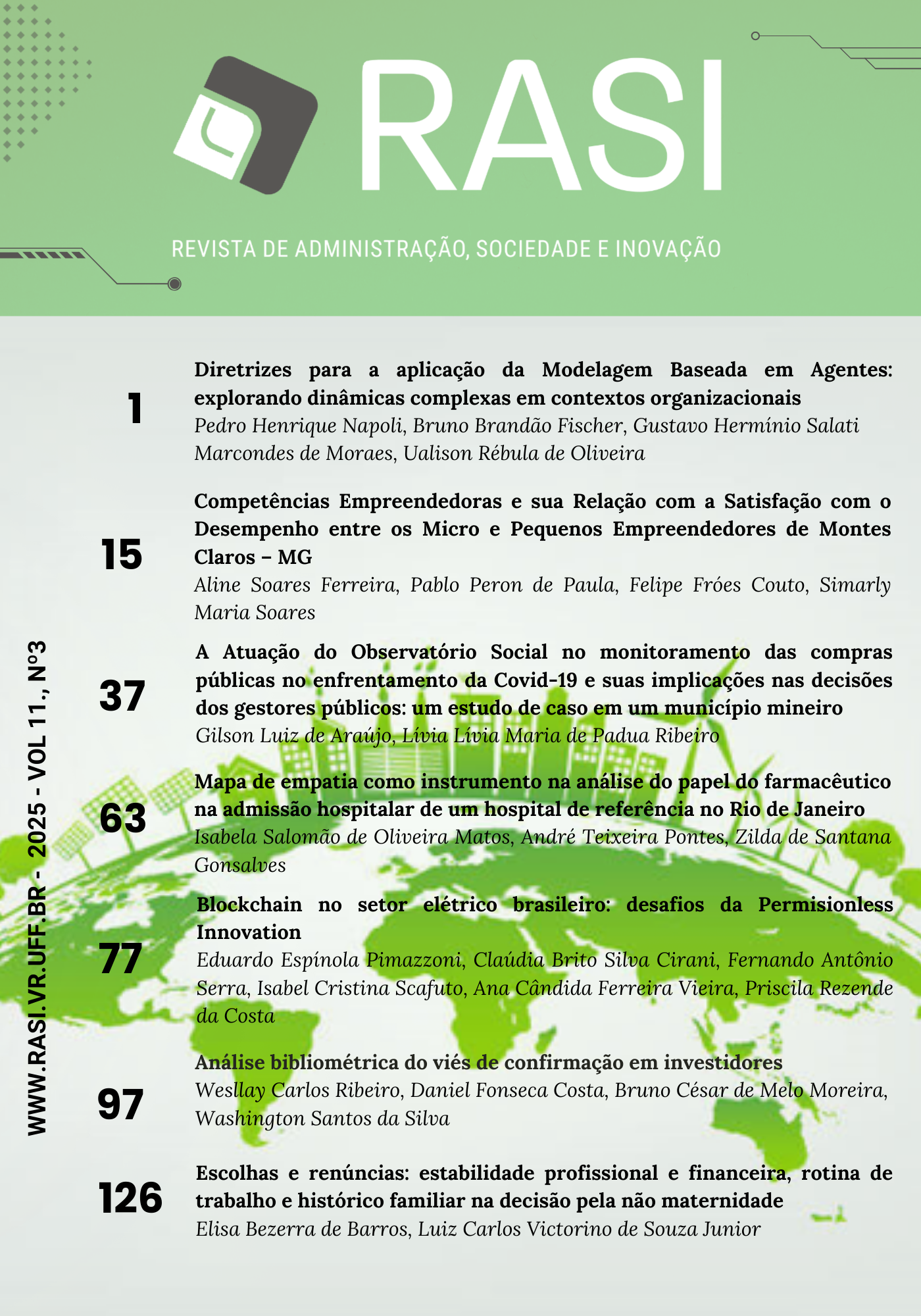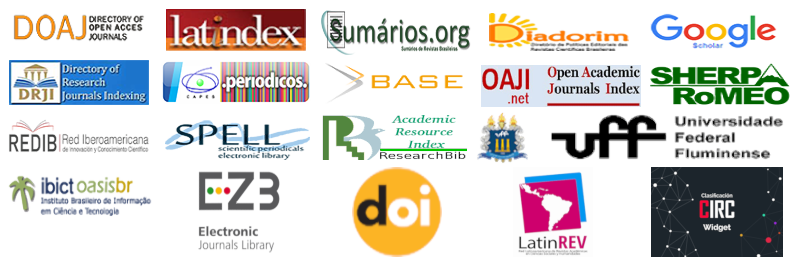Blockchain in the brazilian electric sector: challenges of Permissionless Innovation
DOI:
https://doi.org/10.20401/rasi.11.3.1003Keywords:
Blockchain; Energy; Innovation; Barriers; Permissionless innovation theory.Abstract
Among the numerous sectors of the economy in which blockchain technology is already present, the electricity sector stands out as one of the most promising for its adoption. Although still not widely known by many, this technology is already being applied in areas where challenges find more viable solutions through its use. However, the energy sector is highly complex and regulated, which often hinders the adoption of new technologies, limiting opportunities and restricting the development of new businesses that could benefit from blockchain.
This study aims to demonstrate how blockchain technology can be applied to the brazilian energy sector, considering the following research question: How do companies in the brazilian electricity sector address the challenges of adopting and using blockchain technology? The methodology used was an exploratory study based on interviews with industry experts and executives, covering five companies of small, medium, and large sizes operating in Brazil and abroad, with cases of blockchain technology applicability. The results obtained highlight the difficulties and challenges faced by companies in Brazil when implementing blockchain in the energy sector. The analysis was conducted in light of the permissionless innovation theory, emphasizing the impacts of criticism and regulations that often hinder the advancement and adoption of this technology in the sector.
Downloads
References
Abdella, J., & Shuaib, K. (2018). Peer to peer distributed energy trading in smart grids: A survey. Energies, 11(6). https://doi.org/10.3390/en11061560.
Aguinis, H., Villamor, I., Lazzarini, S. G., Vassolo, R. S., Amorós, J. E., & Allen, D. G. (2020). Conducting Management Research in Latin America: Why and What’s in It for You? Journal of Management, 1–22. https://doi.org/10.1177/0149206320901581.
Andoni, M., Robu, V., Flynn, D., Abram, S., Geach, D., Jenkins, D., McCallum, P., & Peacock, A. (2019). Blockchain technology in the energy sector: A systematic review of challenges and opportunities. Renewable and Sustainable Energy Reviews, 100(October 2018), 143–174. https://doi.org/10.1016/j.rser.2018.10.014.
Baliga, A. (2017). Understanding Blockchain Consensus Models. Whitepaper, April, 1–14. https://www.persistent.com/wp-content/uploads/2017/04/WP-Understanding-Blockchain-Consensus-Models.pdf.
Blind, K. (2013). The Impact of Standardization and Standards on Innovation. 13, 32. www.nesta.org.uk/wp13-15.
Bresnahan, T. F., & Trajtenberg, M. (1992). General Purpose Technologies "Engines of Growth?" NBER Working Paper. Disponível em https://ssrn.com/abstract=282685. Recuperado em 15 junho, 2019.
Bronski, P. (2019). The Energy Sector Needs to Stop Seeing Blockchain as a Disruption. CCEE. (2012). Construindo um mercado inteligente de energia elétrica no Brasil.
Chitchyan, R., & Murkin, J. (2018). Review of blockchain technology and its expectations: Case of the energy sector. arXiv preprint arXiv:1803.03567.
Cointelegraph, B. (2019). O que é Blockchain e como esta tecnologia funciona? Disponível: https://br.cointelegraph.com/tags/blockchain. Recuperado em 18 junho, 2019.
Costa, A. B. (2006). O desenvolvimento econômico na visão de Joseph Schumpeter. Cadernos IHU Ideias, 47, 1–22. http://www.ihu.unisinos.br/images/stories/cadernos/ideias/047cadernosihuideias.pdf.
Creswell, J. W. (2010). Seleção de um Projeto de Pesquisa. In Projeto de pesquisa: Métodos qualitativo, quantitativo e misto.
Creswell, J. W. (2016). Creswell, J.W. projeto de pesquisa- método qualitativo, quantitativo e misto. Tradução de Luciana de oliveira da rocha. 3 Ed. Porto Alegre-artmed, 2016. In Artmed.
Dotson, T. (2015). Technological Determinism and Permissionless Innovation as Technocratic Governing Mentalities: Psychocultural Barriers to the Democratization of Technology. Engaging Science, Technology, and Society, 1, 98–120. https://doi.org/10.17351/ests2015.009.
Ettlin, A. (2018). Dynamic modeling of peer-to-peer power market making. International Conference on the European Energy Market, EEM, 1–5. https://doi.org/10.1109/EEM.2018.8469775
Ferreira, J. E., Pinto, F. G. C., & Santos, S. C. (2017). Estudo de Mapeamento Sistemático sobre as Tendências e Desafios do Blockchain. Gestão Org, 15(Special), 108–117. https://doi.org/10.21714/1679-18272017v15ed.p108-117
Hess, D. (2009). Alternative Pathways in Science and Industry: Activism, Innovation, and the Environment in an Era of Globalization. American Journal of Sociology. https://doi.org/10.1086/599998.
Hess, D. (2015). Power, Ideology, and Technological Determinism. Engaging Science, Technology, and Society, 1, 121–125. https://doi.org/10.17351/ests2015.010.
Jackson, A., Lloyd, A., Macinante, J., & Hüwener, M. (2018). Networked Carbon Markets. Transforming Climate Finance and Green Investment with Blockchains, 255–268. https://doi.org/10.1016/b978-0-12-814447-3.00019-7.
Jesus, E. F., Chicarino, V. R. L., De Albuquerque, C. V. N., & Rocha, A. A. D. A. (2018). A Survey of How to Use Blockchain to Secure Internet of Things and the Stalker Attack. Security and Communication Networks. https://doi.org/10.1155/2018/9675050.
Jogunola, O., Ikpehai, A., Anoh, K., Adebisi, B., Hammoudeh, M., Gacanin, H., & Harris, G. (2018). Comparative analysis of P2P architectures for energy trading and sharing. Energies, 11(1), 1–20. https://doi.org/10.3390/en11010062.
K. Yin, R. (2019). Case Study Research: Design and Methods. In: SAGE Publications. International Educational and Professional Publisher. https://doi.org/10.4324/9780429059056-6.
Kümmel, R., Ayres, R. U., & Lindenberger, D. (2010). Thermodynamic laws, economic methods and the productive power of energy. Journal of Non-Equilibrium Thermodynamics, 35(2), 145–179. https://doi.org/10.1515/JNETDY.2010.009.
Marshall, C., & Rossman, G. B. (2006). Designing Qualitative Research. Sage Publications, 4.
Miseviciute, J. (2018). Blockchain and virtual currency regulation in the EU. Journal of Investment Compliance, 19(3), 33–38. https://doi.org/10.1108/joic-04-2018-0026.
Mylrea, M., & Gourisetti, S. N. G. (2017). Blockchain for smart grid resilience: Exchanging distributed energy at speed, scale and security. Proceedings - 2017 Resilience Week, 18–23. https://doi.org/10.1109/RWEEK.2017.8088642.
Natarajan, H., Krause, S., & Gradstein, H. (2017). Distributed Ledger Technology and Blockchain. World Bank Group. World Bank. https://doi.org/10.1596/29053.
OECD, E. (2018). Presentación Oslo Manual 2018. https://doi.org/10.1787/9789264304604.
Pimazzoni, E., & Revoredo, T. (2018). A energia como estratégia no planejamento econômico-social. Estadão, 1–8.
Pimazzoni, E., & Revoredo, T. (2019). Casos de sucesso da tecnologia blockchain no setor de energia. Estadao.
Rifi, N., Agoulmine, N., Chendeb Taher, N., & Rachkidi, E. (2018). Blockchain Technology: Is It a Good Candidate for Securing IoT Sensitive Medical Data? Wireless Communications and Mobile Computing, 2018. https://doi.org/10.1155/2018/9763937.
Seba, T. (2016). Clean Disruption - Why Conventional Energy & Transportation will be Obsolete by 2030 - Oslo, March 2016 - YouTube. YouTube.
Selltiz, C., Wrightsman, L. S., Cook, S. W., & Kidder, L. H. (2007). Métodos de pesquisa nas relações sociais: medidas na pesquisa social. EPU.
Shen, C., & Pena-Mora, F. (2018). Blockchain for Cities - A Systematic Literature Review. IEEE Access, 6(December), 76787–76819. https://doi.org/10.1109/ACCESS.2018.2880744.
Spradley, J. P. (1979). The Ethnographic Interview. New York, NY: Harcourt Brace Jovanich College Publisher.
Teece, D. J. (1986). Profiting from technological innovation: Implications for integration, collaboration, licensing and public policy. Research Policy, 15(6), 285–305. https://doi.org/10.1016/0048-7333(86)90027-2.
Thierer, A. (2016a). Permissionless innovation : the continuing case for comprehensive technological freedom (Revised an). Mercatus Center - George Mason University.
Thierer, A. (2016b). Permissionless innovation and public policy: Mercatus Center - George Mason University.
Tidd, J. (2005). Managing innovation [electronic resource: integrating technological, market and organization change. In: Managing Innovation: Integration Technological, Market and Organizational Change.
Wang, J., Wang, Q., Zhou, N., & Chi, Y. (2017). A novel electricity transaction mode of microgrids based on blockchain and continuous double auction. Energies, 10(12), 1–22. https://doi.org/10.3390/en10121971.
Wang, N., Zhou, X., Lu, X., Guan, Z., Wu, L., Du, X., & Guizani, M. (2019). When energy trading meets blockchain in electrical power system: The state of the art. Applied Sciences (Switzerland), 9(8). https://doi.org/10.3390/app9081561.
Xu, C., Wang, K., Li, P., Guo, S., Luo, J., Ye, B., & Guo, M. (2019). Making Big Data Open in Edges: A Resource-Efficient Blockchain-Based Approach. IEEE Transactions on Parallel and Distributed Systems, 30(4), 870–882. https://doi.org/10.1109/TPDS.2018.2871449.
Zheng, Z., Xie, S., Dai, H. N., Chen, X., & Wang, H. (2018). Blockchain challenges and opportunities: A survey. International Journal of Web and Grid Services, 14(4), 352–375. https://doi.org/10.1504/IJWGS.2018.095647
Downloads
Published
Issue
Section
License
Copyright (c) 2025 Review of Administration, Society and Innovation

This work is licensed under a Creative Commons Attribution 4.0 International License.
RASI, in accordance with Law No. 9,610 of February 19, 1998, which amends, updates and consolidates Brazilian copyright law and makes other provisions, adopts the following conditions of the Copyright Assignment:
1. RASI maintains, with the transfer of copyrights, the possession of rights over the content published;
2. The author retains his moral rights of the content, including the right to be identified as the author whenever the content is published;
3. Despite the attribution of copyright, the author retains the right to reuse the material in future collections of his own work without encumbrance. The acknowledgments of the previous publication in the RASI are the only requirements in such cases;
4. The author may make photocopies of the content, or distribute it by electronic mail or fax, provided that they are intended for their own classes and for the purpose of meeting research objectives, provided that: (a) such copies are not resold and (b) reference to the original source of the publication and the name of the RASI are clearly indicated on all copies made of the document.











